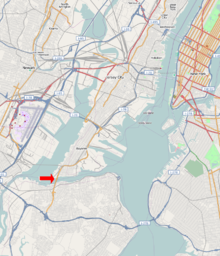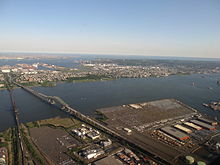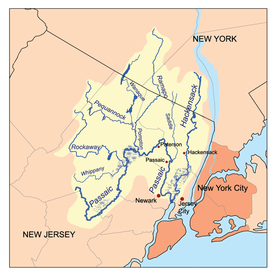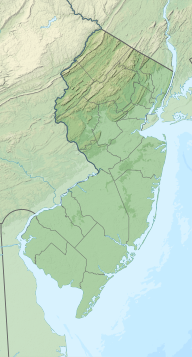Newark Bay
| Newark Bay | |
|---|---|
 Port Newarkis seen in the foreground looking northeast across the bay toJersey Cityand theManhattanborough of New York City. | |
| Location | New Jersey |
| Coordinates | 40°40′47″N74°07′53″W/ 40.679597°N 74.131451°W |
| Type | Bay |
Newark Bayis atidalbayat theconfluenceof thePassaicandHackensackRivers innortheastern New Jersey.It is home to thePort Newark-Elizabeth Marine Terminal,the largestcontainer shippingfacility inPort of New York and New Jersey,the second busiest in the United States. Anestuary,it is periodicallydredgedto accommodate seafaring ships.
Geography
[edit]
Newark Bay is rectangular, approximately 5.5 miles (8.9 km) long, varying in width from 0.6 to 1.2 miles (0.97 to 1.93 km).[1]It is enclosed on the west by the cities ofNewarkandElizabeth,and on the east byJersey CityandBayonne.At the south isStaten Island,New York and at the northKearny PointandDroyer's Pointmark the mouth of the Hackensack.Shooters Islandis abird sanctuarywhere the borders of Staten Island,BayonneandElizabethmeet at one point.[2]The southern tip ofBergen Neck,known asBergen Point,juts into the bay and lent its name to the former Bergen Point Lighthouse. Built offshore in 1849 it was demolished and replaced with a skeletal tower in the mid 20th century.[3]
TheAtlantic OceanatSandy HookandRockaway Pointis approximately 11 miles (18 km) away and reached by tidalstraitsdredged to maintainshipping lanes.Newark Bay is connected toUpper New York Bayby theKill Van Kulland toRaritan Bayby theArthur Kill.The names of the channels reflect the period ofDutch colonialization.The area around the bay was calledAchter Kol,which translates asbehind or beyond the ridgeand refers toBergen Hill.The emergence of theHudson Palisadesbegins onBergen Neck,the peninsula between the bay and theHudson River.KillinDutchmeans stream or channel. During the British colonial era the bay was known asCull bay.[4] Kill van Kull literally translates aschannel from the ridge.Arthur Kill is ananglicizationofachter killmeaningback channel,which would speak to its location behind Staten Island.
Many of the maritime and distribution facilities along the bay are part ofForeign Trade Zone 49.[5]
Bridges
[edit]
The bay is spanned by theVincent R. Casciano Memorial Bridgewhich carries theNewark Bay Extension(Interstate 78) of theNew Jersey Turnpike.TheUpper Bay Bridgeis avertical-lift bridgenorth of the Casciano that is now used byCSX Transportationfor freight shipment, including the notableJuice Train.Central Railroad of New Jersey'sNewark Bay Bridgecrossed the bay from 1864 to connect itsCommunipaw Terminal.Last used in 1978, it was determined to be a hazard to maritime navigation and demolished in the 1980s.
Shoreline
[edit]Elizabethport to the Ironbound
[edit]

Elizabethis the site of the firstEnglish speakingEuropean settlement (1675) inNew Jersey,its port at the southern end of the bay a major maritime hub during the colonial era.Jersey Gardens,an outlet mall, has been located north ofElizabethportsince 1999. There are plans to construct a mixed used community adjacent to it along the bay.[6]
The western edge of Newark Bay was originally shallow tidalwetlandscovering approximately 12 square miles (31 km2). In the 1910s, the city of Newark began excavating an angled shippingchannelin the northeastern quadrant of the wetland which formed the basis of Port Newark.[7][8]Work on the channel and terminal facilities on its north side accelerated duringWorld War I,when the federal government took control of Port Newark. During the war there were close to 25,000 troops stationed at the Newark Bay Shipyard.[9][10]
The city decided to expand the port at the end of the war.[11]ThePort Authority of New York and New Jerseywas formed in 1921[12]and the Newark Bay Channels were authorized by theRivers and Harbors Actsin 1922. Shipping operations languished after the war, and in 1927, the City of Newark started construction ofNewark Liberty International Airporton the northwest quadrant of the wetlands which lay between Port Newark and the edge of the developed city. Port Authority took over the operations of Port Newark and the Newark Airport in 1948 and began modernizing and expanding both facilities southward. In 1958, the Port Authority dredged another shipping channel which straightened the course of Bound Brook, the tidalinletforming the boundary between Newark and Elizabeth. Dredged materials was used to create new upland south of the new Elizabeth Channel, where the Port Authority constructed the Elizabeth Marine Terminal. The first shipping facility to open upon the Elizabeth Channel was the new 90-acre (36 ha)Sea-LandContainer Terminal,which was the prototype for virtually every other container terminal constructed thereafter.[13]
TheIronboundis an industrial area along the bay which becomes residential farther inland nearDowntown Newark.
Kearny Point
[edit]TheCentral Railroad of New Jerseyfirst built theNewark and New York Railroadacross the rivers and tip of New Barbadoes Neck in 1869. One bridge was taken out of service in 1946 after a ship collided into it. Passenger service on the other bridge, thePD Draw,was discontinued in 1967. TheKearny Pointpeninsula is site of the River Terminal, a massive distribution facility.[14]It comprises the formerWestern ElectricKearny Works andFederal Shipbuilding and Drydock Company,theshipyardsof which operated from 1917 to 1949, and played a prominent role in bothWorld War IandWorld War II.[15]
Bergen Point to Droyer's Point
[edit]
While there was some maritime development on the eastern banks of the bay closerBergen Pointmost of the eastern shore abuts residential and recreational areas. TheHackensack RiverWalkis a partially completedlinear parkgreenwayintended to link the string of parks along its banks and that of theHackensack Riverfrom theBayonne Bridgeto theHackensack MeadowlandsinSecaucusandNorth Bergen.In Bayonne, much of the bay has not seenbulkheaddevelopment, and hence has a natural shoreline. The city's largest parks are its shores.[16][17]AtDroyer's Pointrecreational and residential development have included apromenade.
Howland Hook
[edit]TheHowland Hook Marine Terminalis acontainerport facility located at the northwestern corner ofStaten Islandat the entrance to the Arthur Kill. Nearby isPort Ivory,named for theIvory Soapplant once located there.[18]To the east is the residential neighborhood ofMariners Harborwhich overlooks the bay. In the first half of the 20th century,Bethlehem Steelmaintained a plant which built military transports during World War I and World War II.[19][20]Currently,tugboatcompanies and number of smallerdry docksoperate along the shore.
Pollution and marine life
[edit]
The bay is notoriously polluted, and it is now aSuperfundsite. "One blue crab in Newark Bay has enough dioxin to give somebody cancer," said David Pringle, spokesman forClean Water Action.[21]
Both thetributaries,particularly the Passaic River, have sections which are lined with heavy industry.[22]Some industrial facilities discharged wastes into the tributaries during the nineteenth and twentieth centuries, prior to passage of the 1972Clean Water Act.High levels ofPCBsanddioxinhave been detected in the bay. It also has high levels ofmercury,copperand othertoxicchemicals.[23]
While illegal discharges of chemical waste have been stopped,crabbingis illegal andfishingis limited due to chemicals that remain in thesediment.[24][25]
Pronounced endocrine disruption and reproductive effects have been reported in Newark BayMummichog,often used as a sentinel and bioindicator species.[26]Reproductive effects reported are primarily due to a chemical inhibition ofvitellogenesisandoogenesis,which are highly conserved processes foroviparous(egg-laying) animals.[27]Killifish within Newark Bay have also been reported to chemically adapt (desensitize) to aryl hydrocarbon receptor mediated pollutants (i.e. dioxins).[28]Killifish within Newark Bay have emerged as a popular tool for studying population effects of historical and emerging chemicals of concern due to their chronic exposure to complex mixtures of common contaminants, and subsequent effects due to living within a polluted environment.
2008 Liberian freighter collision
[edit]In January 2008, a 117 ft.Great Lakes Dredge and Dock Companydredge in Newark Bay was struck by a 669-ft Liberian-flaggedorange juicefreighter named theOrange Sun.Newark Bay had to be closed for five hours by theU.S. Coast Guarduntil damages to the GLD&D dredge were mitigated. The dredge had begun to take on water and a diving crew was sent in order to make repairs.[29]In December 2009, theNational Transportation Safety Boardissued a report that blamed theOrange Sunfor the accident. TheOrange Sun's master had not informed the captain or crew about the ship's tendency to deviate from its course.[30]
See also
[edit]- Geography of New York–New Jersey Harbor Estuary
- List of bridges, tunnels, and cuts in Hudson County, New Jersey
- Marine life of New York-New Jersey Harbor Estuary
- Newark Bay rail accident
- Timeline of Jersey City area railroads
References
[edit]- ^"US Army Corps of Engineers: Newark Bay"(PDF).Archived fromthe original(PDF)on 2010-05-28.Retrieved2010-04-18.
- ^Hudson County New Jersey Street Map.Hagstrom Map Company, Inc. 2008.ISBN978-0-88097-763-0.
- ^Bergen Point LighthouseArchived2010-04-09 at theWayback Machine,1849-1949, New Jersey Lighthouse Society.
- ^Grabas, Joseph A."Land Speculation and Proprietary Beginnings of New Jersey"(PDF).The Advocate.XVI(4): 3, 20, 14. Archived fromthe original(PDF)on November 20, 2008.RetrievedApril 15,2010.
- ^"PANYNJ FTZ 49".Archivedfrom the original on 2019-10-19.Retrieved2010-04-19.
- ^$2B MXD Planned for Elizabeth WaterfrontArchived2012-06-12 at theWayback Machine
- ^"TO MAKE NEWARK BAY A BIG PORT; The Jersey Meadow's Being Transformed Into a Busy Spot, with Docks and Reclaimed Land"(PDF).The New York Times.27 June 1915.Archived(PDF)from the original on 14 February 2022.Retrieved14 June2018.
- ^French, Kenneth (February 24, 2002).Images of America:Railroads of Hoboken and Jersey City.Portsmouth, New Hampshire:Arcadia Publishing.pp. 25–29.ISBN978-0-7385-0966-2.Archived fromthe originalon July 18, 2011.RetrievedNovember 21,2009.
- ^"Newark Bay Shipyard".Archivedfrom the original on 2009-09-05.Retrieved2010-04-19.
- ^"Newark Bay Shipyard".Archivedfrom the original on 2010-02-23.Retrieved2010-05-03.
- ^"THE CITY OF NEWARK TO EXPEND $1,250,000 IN THE DEVELOPMENT OF NEWARK BAY AS A SEAPORT; Unwilling in Wait Langer for Government Aid the City Authorities Authorize the Issuance of bonds to Provide Funds for Deepening of Channel to Accommodate the Largest Vessels--Plan Endorsed by Business Men"(PDF).The New York Times.31 July 1921.
- ^"of New York and New Jersey".Archived fromthe originalon 2011-06-11.Retrieved2010-04-15.
- ^"History - Port of New York and New Jersey - Port Authority of New York & New Jersey".Archivedfrom the original on 2019-10-19.Retrieved2010-04-17.
- ^"River Terminal".Archivedfrom the original on 2010-05-18.Retrieved2010-04-15.
- ^"Kearny Yard".Archivedfrom the original on 2006-10-31.Retrieved2010-04-15.
- ^Hackenack Riverwalk Plan proposal 2003Archived2009-09-10 at theLibrary of CongressWeb Archives
- ^Hudson County Master Plan[permanent dead link]
- ^"Ongoing Projects:: Port Ivory".Longleaf Lumber. Archived fromthe originalon 2010-10-15.Retrieved2010-04-15.
- ^"Mariners Harbor Shipyard".Archivedfrom the original on 2010-08-10.Retrieved2010-05-03.
- ^"Bethlehem Shipbuilding: List of Ships built at Staten Island".Archivedfrom the original on 2010-02-21.Retrieved2010-05-03.
- ^"Outrage Over Company Backing Out of Superfund Cleanup Through Bankruptcy".NJTV News.2017-04-18.Archivedfrom the original on 2018-01-14.Retrieved2018-01-14.
- ^"Watershed Database and Mapping Projects/Newark Bay (New Jersey)."Archived2010-05-28 at theWayback MachineNational Ocean Service, Office of Response and Restoration. Silver Spring, MD. March 2007.
- ^"Comprehensive Conservation and Management Plan: Management of Toxic Contamination"(PDF).U.S. Environmental Protection Agency (EPA). March 1996.Archived(PDF)from the original on 2008-11-20.Retrieved2009-04-03.
- ^"Fish Advisories".Trenton, NJ: New Jersey Department of Environmental Protection (NJDEP). 29 May 2009.Archivedfrom the original on 27 May 2009.Retrieved3 April2009.
- ^"Blue Claw Crab Alert".NJDEP. 2009-12-02.Archivedfrom the original on 2009-05-30.Retrieved2010-04-19.
- ^Bugel, Sean M.; White, Lori A.; Cooper, Keith R. (18 Feb 2010). "Impaired reproductive health of killifish (Fundulus heteroclitus) inhabiting Newark Bay, NJ, a chronically contaminated estuary".Aquatic Toxicology.96(3): 182–193.doi:10.1016/j.aquatox.2009.10.016.PMID20079544.
- ^Bugel, S. M.; White, L. A.; Cooper, K. R. (22 Mar 2011)."Decreased vitellogenin inducibility and 17β-estradiol levels correlated with reduced egg production in killifish (Fundulus heteroclitus) from Newark Bay, NJ".Aquatic Toxicology.105(1–2): 1–12.doi:10.1016/j.aquatox.2011.03.013.PMC4798252.PMID21684236.
- ^Prince, Ruth; Cooper, Keith R. (26 Oct 1995). "Comparisons of the effects of 2,3,7,8-tetrachlorodibenzo-p-dioxin on chemically impacted and nonimpacted subpopulations of Fundulus heteroclitus: I. TCDD toxicity".Environmental Toxicology and Chemistry.14(4): 579–587.doi:10.1002/etc.5620140405.
- ^"Accident Closes Major Shipping Channel for Hours".The New York Times.2008-01-25.Archivedfrom the original on 2018-01-06.Retrieved2017-02-17.
- ^"Federal report blames ship carrying orange juice for Newark Bay collision last year".NJ On-Line.2009-12-09.Archivedfrom the original on 2015-06-22.Retrieved2015-01-16.
External links
[edit]- "Fishing for Answers in an Urban Estuary"—Teaching Guide About Newark Bay for Elementary Schools (NJDEP)
- New York–New Jersey Harbor Estuary Program—US EPA
- US EPA: Newark Bay Study 2004
- US Army Corps of Engineers: Newark Bay



